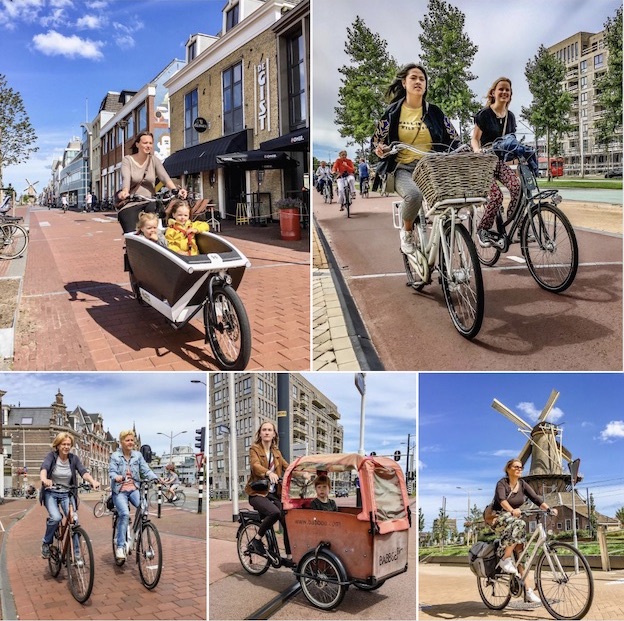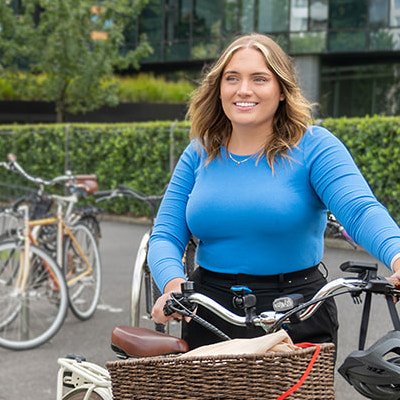How can our streets and neighbourhoods welcome women?
Women deserve the freedom to move safely, conveniently and enjoyably around Yarra, e.g. to walk or cycle to work, shops, or their friends houses.
…for many women, walking is more appealing than organised sport…Developing neighbourhood walking routes that specifically target women will support them to walk more often…Some identified walking routes will need small infrastructure improvements to ensure they are safe and convenient.
Victoria Walks, Getting Victorians back on their feet

Hear from Angela Brett, making a submission in support of cycling infrastructure to Christchurch City Council – the same issues apply in Yarra.
What Yarra can do
Yarra can make streets better for women by building:
- wider footpaths and safe crossings,
- protected bicycle lanes that link 30 km/h streets in Low Traffic Neighbourhoods,
- protected level-access tram stops, and
- improved lighting and ‘eyes on the street’.
Budget is needed to pay for the necessary infrastructure improvements, and revenue is available by reforming the pricing of on-street parking. Unfortunately, council faces several barriers to implementation, including:
- Some residents don’t want council to allocate more street space to walking and cycling
- Some residents don’t want council to charge market rates for on-street parking
Each of us can help by showing our support for an increased allocation of street space and budget for walking and cycling, e.g. by appearing as a champion on the Streets Alive Yarra website.
Designing for women
Our street design currently focusses on the car first and places people last. One of the most natural things we could do is reverse that thinking. As a general rule, men drive more than women, but women walk more, so its women who are the higher users of our pedestrian facilities. There must be a change of thinking so that a pedestrian-friendly environment would be created first, and then we could consider how to integrate vehicles into the remaining area. This change of thinking would enable women equitable access to our cities infrastructure.
Emma McInnes, Urban Designer at Resilio Studio and co-founder of Women in Urbanism Aotearoa.

A feminist city
A feminist city must be one where barriers—physical and social—are dismantled, where all bodies are welcome and accommodated. A feminist city must be care-centered, not because women should remain largely responsible for care work, but because the city has the potential to spread care work more evenly. A feminist city must look to the creative tools that women have always used to support one another and find ways to build that support into the very fabric of the urban world.
Leslie Kern, writing in Feminist City – Claiming Space in a Man-Made World

Guidance from the City of Sydney
Safety is the most common barrier to walking and a leading concern for bike riding overall. 64% of respondents said separated cycleways are a huge factor in helping them feel safe when riding.
–
Thinking about active transport not only as footpaths, shared paths, bike lanes and separated cycleways, but also as a network of active, well-used and welcoming places, creates opportunities for passive surveillance and helps to create a greater sense of safety.
–
Every street should be considered part of the walking and cycling network, with the aim of including, at a minimum, a shared walking and cycling path.
On the go: how women travel around our city

Guidance from Monash University
Dr Lauren Pearson advises that a cohesive network of protected bike lanes is key to encouraging more women to cycle:
Guidance from the Netherlands
Safety is often cited as the sole reason Dutch women cycle more than men. But it’s not that simple. Their fine-grained networks support a wide variety of distances and destinations; accomodating complex, multi-purpose travel patterns outside of the “normal” 9-to-5 commute.
Chris Bruntlett, Dutch Cycling Embassy

Guidance from the Institute of Transportation Engineers
The Women of the Institute of Transportation Engineers (ITE) Sub-Committee report that women need:
- Safety:
- streets should be safe for people on bikes
- public space should be considered socially safe, also in evenings or in more deserted locations
- A positive image:
- cycling should not be considered an inherently dangerous activity (which may be suitable for reckless men, but not for women)
- cycling should be acknowledged as a suitable mode of urban transportation, not just for sport
- Hassle-free:
- easy access to bicycles in all shapes, sizes and colours (not everyone wants a carbon racing bike)
- easy access to bicycle accessories like panniers, mudguards, and dress guard (better yet, bicycles that come already fully accessorized)
- easy access to child seats, shopping trailers and dog trailers, and cargo bikes
- Proximity:
- spatial planning can contribute to making more destinations (like schools and shops) within reach for cycling trips
- Space for practicing in the streets:
- children who learn to cycle in playgrounds and quiet streets from a young age onwards, should be accommodated to cycle in the streets with their parents to learn about what to anticipate in traffic
- adults who have not had the opportunity before (most of whom are women), should have the opportunity to learn to cycle
Conclusion
We know how to make Yarra’s streets better for women, we just need to deliver it.
Champion
Your champion for this page is Lauren Pearson, Research Fellow at Monash University. View all of Streets Alive Yarra’s champions on our supporters page.

Bike riding is the magic pill to be able to overcome some of the issues we face in the current health and climate crisis, but significantly less women are able to ride due to the additional barriers they experience. Streets Alive Yarra plays a key role in including and empowering women to drive the conversation about what they need to be able to ride a bike, crucial to enabling equitable bike riding. The initiative provides a critical platform to ensure that as we move to more sustainable and healthy modes of transport, women aren’t left behind.
Lauren Pearson
